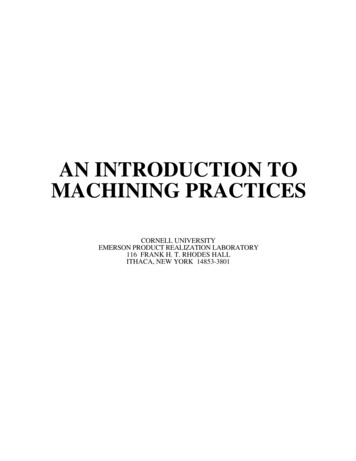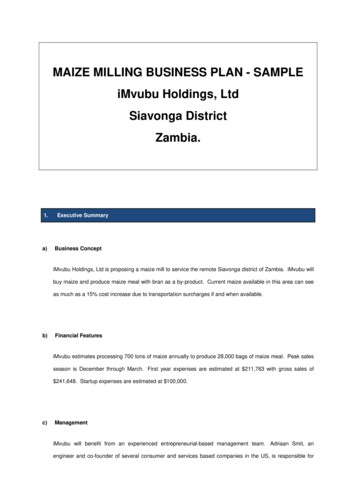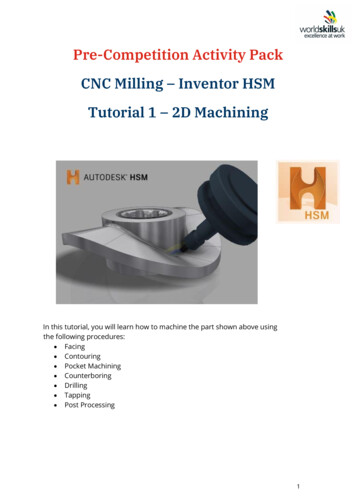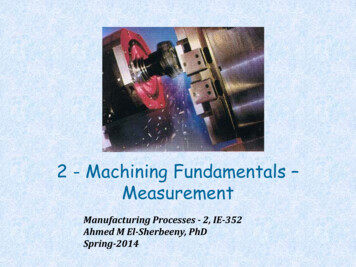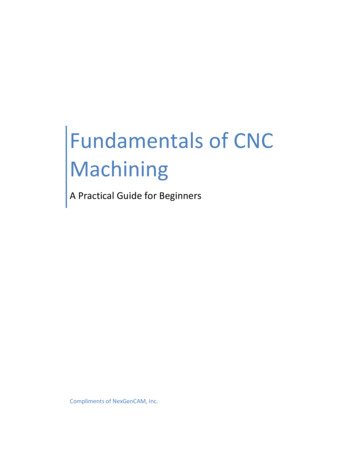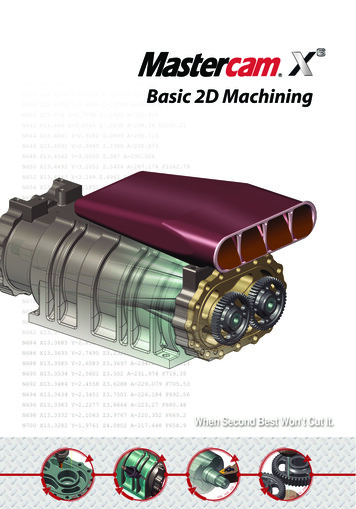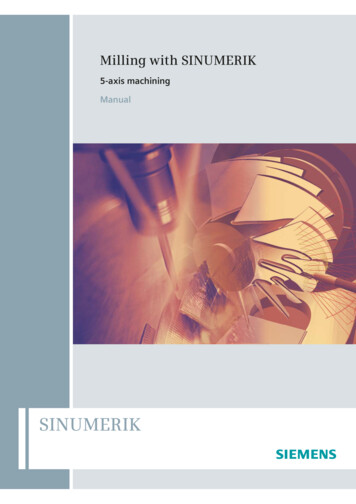
Transcription
Introduction to Machining:Milling Machine
Vertical Milling Machineis Most Common Milling machines are very versatile. They are usually used to machine flatsurfaces, but can also produce irregular surfaces. They can also be used todrill, bore, cut gears, and produce slots. The type of milling machine most commonly found in student shops is avertical spindle machine with a swiveling head. Although there are severalother types of milling machines, shown is the vertical milling machine. A milling machine removes metal by rotating a multi-toothed cutter that isfed into the moving workpiece. The spindle can be fed up and down with aquill feed lever on the head. The bed can also by fed in the x, y, and z axes manually. Once an axis islocated at a desired position and will no longer be fed, it should be lockedinto position with the gibb locks. Most milling machines are equipped with power feed for one or moreaxes. Power feed is smoother than manual feed and, therefore, canproduce a better surface finish. Power feed also reduces operator fatigueon long cuts. On some machines, the power feed is controlled by aforward reverse lever and a speed control knob.
Typical, Basic Milling Machine
Tramming the Head The head of a vertical milling machine can betilted from side to side and from front to back.This allows for versatility of the machine, butthese adjustments can drift. Occasionally, oneshould check and adjust the head so that thespindle will be normal to the plane of thetable.
Milling Vises
Vises Work on a milling machine is most often heldin a vise clamped onto the bed. To makefeatures aligned with the edges of the stock,it's necessary to align the vise with the feedaxes of the mill. To do this, mount the vise onthe bed and secure it with T-bolts, but onlylightly so as to permit adjustment of theorientation of the vise.
Cutters In vertical mills, milling cutters with solid shaftsare usually used. Milling cutters with keyed holesare predominantly for use in horizontal mills. Endmills are designed for cutting slots, keyways andpockets. Two fluted end mills can be used toplunge into work like a drill. End mills with morethan two flutes should not be plunged into thework. Ball end mills can produce a fillet. Formedmilling cutters can be used to produce a variety offeatures including round edges. Use More flutes for finer finish at lower MRR.
Cutters (Mills)
End Mills Have cutting teeth at one end, as well as onthe sides
Installing & Removing Cutters End mill cutters can be held by the spindle in severalways; a few of the ways are shown in the figurebelow. On most machines, a draw bar is used to pulla spring collet into a taper in the spindle
Spring Collets Locking Morse taper
Climb vs. Conventional Milling When milling, one should be aware of the differencebetween conventional, and climb milling. Inconventional milling, the workpiece is fed into therotation of the cutter. This type of cut requires lowerforces and is preferred for roughing cuts.ConventionalClimb
Climb vs. Conventional Milling In climb milling, the work moves with therotation of the cutter. This produces a betterfinish. It is not recommended if the workpiececannot be held securely or cannot supporthigh forces.Climb
Conventional Milling vs. Climb ConventionalClimb
Calculating Speeds and Feeds Cutting speed refers to the speed at which thetool point of the cutter moves with respect tothe work measured in feet per minute. Feed isthe rate at which the work moves into thecutter measured in feed per tooth revolution.Feeds and speeds affect the time to finish acut, tool life, finish of the machined surfaceand power required of the machine.
Calculating Speeds and Feeds The cutting speed is mostly determined by the materialto be cut and the material of the tool. To find the rightspeed for any task, refer to the Machinery's Handbookor tool manufacturer reference. To calculate the proper spindle speed, divide thedesired cutting speed by the circumference of the toolexpressed in feet. The feed rate depends on the widthand depth of cut, finish desired and many othervariables. To calculate the desired feed setting from thefeed rate, multiply feed per tooth per revolution bynumber of teeth and rpm of the spindle.
https://littlemachineshop.com/mobile/speeds feeds.php
Using an Edge Finder Before doing precise work on a milling machine,one must locate the edges of a part accurately.An edgefinder is designed to help you do this. An edgefinder is composed of two concentriccylinders, spring loaded together. To use it,offset the two halves slightly so that there is awobble as it spins. Then, move the part into thetool slowly. The edge finder will center up, thenbreak out of concentricity suddenly. At that point, reset the dial indicator or digitalreadout for that axis of the machine to a valueequal the radius of the edgefinder. Repeat theprocess at least once.
USING AN EDGE FINDER The edges of a workpiece must be located before doingmill work that requires great accuracy. An edge finderhelps in finding the edges. 800-1200 spindle RPM is recommended. To use an edge finder, slightly offset the two halves sothey wobble as they spin. Slowly move the workpiece towards the edge finder. The edge finder will center itself, then suddenly loseconcentricity. The digital readout tells you the position of the spindle.
Edge finder, Example If the diameter of the edge finder is 0.200″. Soadding or subtracting half of that (0.100″) willbe the tool center. If centering on the top left,– add 0.100″ to the X-axis– subtract 0.100″ from the Y-axis. If centering on the top right,– subtract 0.100″ from the X-axis– subtract 0.100″ from the Y-axis. Part Reference Zero is when the bit is zeroed onthe X and X axes. A pointed edge finder is a lot easier, but not asprecise. Only use a pointed edge finder ifprecision is not necessary.yx
Vises Work on a milling machine is most often held in a vise clamped onto the bed. To make features aligned with the edges of the stock, it's necessary to align the vise with the feed

